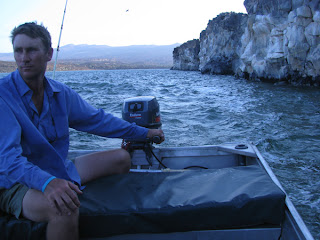At the beginning of December some friends and I embarked on a Nile Perch fishing expedition to Lake Turkana. An utterly unique place, Turkana is, at least for now, unspoiled by development or environmental problems. This of course will likely change when Ethiopia completes their Gilgel Gibe hydroelectric project (funded by China) on the Omo River that feeds the Lake. The Lake is naturally very saline because it has no outlet and a very high evaporation rate and so the series of dams upstream will in all likely hood alter the ecology of the lake itself (because so much more of the evaporation will now happen upstream). Why Kenya has not fought more forcefully against these hydro projects is a mystery (some have said our Prime Minister has shares). In fact Kenya signed up to buy power from the dams before an environmental impact assessment was even complete. The answer is likely that the leadership in Nairobi do not regard the pastoral people (about 300,000 live around Lake Turkana) of northern Kenya as citizens worth fighting for.
The Rumaruti / Maralal to South Horr road is also scheduled to be tarmacked and upgraded with money evidently from Iran. While this will be welcome by most people it will certainly change the nature of Turkana as commercial fishing or commercial tourism might become more possible. As it stands now though, Turkana is a hard place to do business in. Things can go wrong, roads can become impassible with rain, gun battles can erupt over livestock and when cars break down they are a long way from a garage - its all really not for the light hearted traveler or those seeking an easy no-problems vacation.
Despite all that, turkana is an absolutely wonderful place with a desolate, wild beauty. The fishing was great too. Josh Perrett who runs Arid Adventures a four wheel drive rental company and who has circumnavigated the lake with camels, brought a little aluminium boat with an engine, ideal for trolling. We were typically only able to stay out for 3 or 4 hours in the morning before the wind would pick up and we would retreat to our camp. Then in the evening we usaully could get in a few more hours In that time though we would usually come away with about 10 or so fish that would range from 10 lbs to the biggest which was 55lbs (Sadly this was not caught by me but by Steve Carey from Sosian).
The Flyfishing potential up here is huge and in the more protected National Parks along the lake you might expect to have the best chance hooking into a big Perch. I tried a bit while in the South but the wind picked up fast and it was often times too tempting to join Steve and Josh in trolling from the boat. Still though, many people have caught these fish on a fly and so it is very possible. The big Tilapia that travel in great schools are also catchable with a fly as well as very tasty.
While trolling around we saw lots of evidence of local Turkana Fisherman and their longlines. We chatted with these guys and were very impressed with some of their catches. One guy caught the following fish that we estimated at about 120lbs.
Neither Steve or Josh could lift the fish by themselves. The fisherman that took this fish said that he would get about 6000 shillings in Loingalani for the dried fishing bladder while he would only get about 4000 for the dried meat. Evidently the Chinese are buying these for soup and for making beer and wine -??????. Read more here: (http://www.fao.org/docrep/005/t0606b/T0606B06.htm) The fisherman told us that he would expect to catch a fish of this size once a week with many smaller catches in between. This meant that this fisherman as well as all the others were making an excellent living (way above a Kenyan average wage) from this fishery. Something that really impressed me was there were still more fish to catch. While I'm sure that the local fisherman are making a significant impact on the fishery I was astonished at the resiliency of the fishery. I would love to know to what extent the Perch are using the deep water - if their developed swim bladders have everything to do with an ability to operate at any depth in the lake. I wondered if there weren't still swarms of monsters in the deep green depths of Turkana forever out of reach of the local fisherman and their low tech equipment. I imagine there are but at the same time I imagine that will soon change. Moral of the story: Now is the time to visit Turkana.














